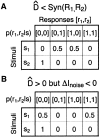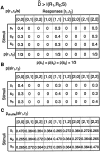Synergy, redundancy, and independence in population codes
- PMID: 14684857
- PMCID: PMC6740962
- DOI: 10.1523/JNEUROSCI.23-37-11539.2003
Synergy, redundancy, and independence in population codes
Abstract
A key issue in understanding the neural code for an ensemble of neurons is the nature and strength of correlations between neurons and how these correlations are related to the stimulus. The issue is complicated by the fact that there is not a single notion of independence or lack of correlation. We distinguish three kinds: (1) activity independence; (2) conditional independence; and (3) information independence. Each notion is related to an information measure: the information between cells, the information between cells given the stimulus, and the synergy of cells about the stimulus, respectively. We show that these measures form an interrelated framework for evaluating contributions of signal and noise correlations to the joint information conveyed about the stimulus and that at least two of the three measures must be calculated to characterize a population code. This framework is compared with others recently proposed in the literature. In addition, we distinguish questions about how information is encoded by a population of neurons from how that information can be decoded. Although information theory is natural and powerful for questions of encoding, it is not sufficient for characterizing the process of decoding. Decoding fundamentally requires an error measure that quantifies the importance of the deviations of estimated stimuli from actual stimuli. Because there is no a priori choice of error measure, questions about decoding cannot be put on the same level of generality as for encoding.
Figures






References
-
- Abbott L, Dayan P ( 1999) The effect of correlated variability on the accuracy of a population code. Neural Comput 11: 91-101. - PubMed
-
- Abeles M, Lass Y ( 1975) Transmission of information by the axon: II. The channel capacity. Biol Cybern 19: 121-125. - PubMed
-
- Abeles M, Bergman H, Margalit E, Vaadia E ( 1993) Spatiotemporal firing patterns in the frontal cortex of behaving monkeys. J Neurophysiol 70: 1629-1638. - PubMed
-
- Aertsen A, Gerstein G, Habib M, Palm G ( 1989) Dynamics of neuronal firing correlation: modulation of “effective connectivity.” J Neurophysiol 61: 900-917. - PubMed
-
- Alonso J, Usrey W, Reid R ( 1996) Precisely correlated firing in cells of the lateral geniculate nucleus. Nature 383: 815-819. - PubMed
Publication types
MeSH terms
LinkOut - more resources
Full Text Sources
Other Literature Sources
